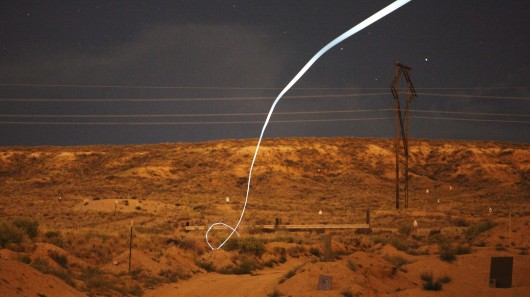Self-guided bullet could hit laser-marked targets from a mile away
By Jan Belezina
13:44 January 31, 2012

The self-guided bullet developed by Sandia National Laboratories has been fitted with an LED, to check if the embedded battery and control electronics can survive the flight
A group of researchers at Sandia National Laboratories have built a prototype of a small-caliber bullet capable of steering itself towards a laser-marked target located approximately 2,000 meters (1.2 miles) away. The dart-like design has passed the initial testing stage, which included computer simulations as well as field-testing prototypes built from commercially available parts.
The four-inch (10 cm) long projectile is to be used with smoothbore arms, meaning ones with non-rifled barrels. Rifling involves cutting helical grooves in the barrel to give the bullet a spin that, thanks to the gyroscopic effect, improves its aerodynamic stability and accuracy. In a self-guided projectile, however, such spinning movement would prevent the bullet from reliably turning towards the target when in flight. For this reason, the group of researchers lead by Red Jones and Brian Kast decided to use a dart-like design that includes tiny fins to allow the projectile to fly straight, without a spin.
While positioning the center of gravity towards the front of the projectile aids the stability, the task of directing the bullet to its target is handled mainly by the little fins. The on-board guidance and control electronics use the information passed on by an optical sensor located in the nose to calculate the flight path. An algorithm in an eight-bit central processing unit is used to control electromagnetic actuators which, in turn, move the fins.
Larger guided projectiles, such as missiles, rely on a device called an inertial measurement unit (IMU) that uses a set of accelerometers and gyroscopes to gather information on velocity, spatial orientation and gravitational forces. Fitting a small-caliber bullet with an IMU would make it extremely expensive. That, however, turned out not to be necessary, as the bullet's size appears to act to its advantage, when compared with larger projectiles.
Any projectile's flight dynamics depends on its mass and size. Both these factors influence the rate at which the projectile pitches and yaws. The rate is slower in larger projectiles, and since fewer path corrections can be done in flight, they need to be very precise. With the smaller projectiles yawing and pitching at a faster rate, as many as 30 corrections per second can be made, and less precision is allowed.
Computer simulation results suggest that, under real world conditions, a traditional bullet is likely to miss a target located 1,000 meters (0.62 miles) away by as much as 9 meters (9.8 yards), while a self-guided bullet would get within 20 cm (8 in) of that target. Oddly enough, the accuracy improves the further away the target is. "Because the bullet's motions settle the longer it is in flight, accuracy improves at longer ranges," Red Jones explains. Of course professional snipers can handle such distances pretty well even now, but the bullet could make their jobs much easier.
Field tests showed that electromagnetic actuation allows the projectile to reach the speed of 2,400 feet per second (730 meters per second) using off-the-shelf gun powder. This falls short of military standards, but the research team is confident that customized gunpowder is all that is needed to give the bullet that extra kick.
The researchers needed to devise a way of checking whether the on-board battery and the electronic components can actually survive the flight, and what they came up with is quite ingenious. They attached a tiny light-emitting diode to the bullet and shot it (took pictures of it, that is) in flight during a night field test. The main image at the top of the page illustrates that the components are robust enough to make it.
Although so far the test results are promising, there are still some engineering issues left to tackle. Sandia is now on the lookout for a private corporate partner that would help make their guided bullet available to the military, law enforcement agencies and some hardcore recreational shooters.
The video below shows the bullet in flight.
